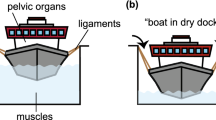Abstract
Introduction and hypothesis
The female pelvic floor is a complex network of ligaments and muscles whose mechanical properties have not been completely understood. The goal of this study is to understand the biomechanical properties of the pelvic floor tissues of young women and the impact of aging.
Methods
Biomechanical uniaxial tension tests were performed on pelvic floor tissues (ligaments and organs) of six young female cadavers (average 29 years old). Results have been analyzed in order to define the characteristics of the mechanical properties of young pelvic soft tissues. Results have been compared with those in the literature in order to understand the similarities and discrepancies between young and old patients.
Results
Damageable, nonlinear elastic biomechanical behavior is observed. The variation in stiffness among the pelvic floor organs could be shown. Ligaments and the vaginal wall are the most rigid organs, whereas the rectum and bladder tend to be less rigid (approximately two times less rigid for small deformations and three times less rigid for large deformations). This study shows that ligaments and the vaginal wall of young women have similar mechanical behavior while those of older women differ. Furthermore, young women’s tissues differ slightly from older women’s tissues.
Conclusions
Results show that aging and possibly diverse “trauma” have an impact on modifying the mechanical behavior of pelvic floor tissues. Over time pelvic floor ligaments and vaginal tissues will differentiate and acquire different mechanical behavior, as seen within the literature in older cadavers.






Similar content being viewed by others
References
Samuelsson EC, Arne Victor FT, Tibblin G et al (1997) Signs of genital prolapse in a Swedish population of women 20 to 59 years of age and possible related factors. Am J Obstet Gynecol 89:501–506
Olsen AL, Smith VJ, Bergstrom JO et al (1997) Epidemiology of surgically managed pelvic organ prolapse and urinary incontinence. Obstet Gynecol 89:501–506
Bump RC, Norton PA (1998) Epidemiology and natural history of pelvic floor dysfunction. Obstet Gynecol Clin North Am 25:723–746
Luber KM, Boero S, Choe JY (2001) The demographics of pelvic floor disorders: current observations and future projections. Am J Obstet Gynecol 184:1496–1503
Rubod C, Brieu M, Cosson M, et al. Biomechanical properties of human pelvic organs. Int Urogynecol J 79(4):968.e17–968.e22. doi:10.1007/s00192-010-1237-7
Rivaux G, Rubod C, Dedet B et al. Uterine ligaments: are they stronger than vaginal tissue? A biomechanics study. Int Urogynecol J (in press)
Epstein LB, Graham CA, Heit MH (2007) Systemic and vaginal biomechanical properties of women with normal vaginal support and pelvic organ prolapse. Am J Obstet Gynecol 197:165.e1–165.e6
Lei L, Song Y, Chen R (2007) Biomechanical properties of prolapsed vaginal tissue in pre- and postmenopausal women. Int Urogynecol J 18:603–607
Qiao Y, Pan E, Chakravarthula SS (2005) Measurement of mechanical properties of rectal wall. J Mater Sci 16:183–188
Clobes A, DeLancey JOL, Morgan DM (2008) Urethral circular smooth muscle in young and old women. Am J Obstet Gynecol 198:587.e1–587.e5
Clay JC, Rubod C, Brieu M et al (2010) Biomechanical properties of prolapsed or non-prolapsed vaginal tissue: impact on prolapse surgery. Int Urogynecol J 21:1535–1538
Rubod C, Boukerrou M, Brieu M et al (2007) Biomechanical properties of vaginal tissue. Part 1: new experimental protocol. J Urol 178:320–325
Mullins L (1947) Effect of stretching on the properties of rubber. J Rubber Res 19:275–289
Merckel Y, Diani J, Brieu M (2011) Experimental characterization and modelling of the cyclic softening of carbon-black filled rubbers. Mater Sci Eng A 528:8651–8659
Merckel Y, Diani J, Brieu M (2011) A Mullins softening criterion for general loading conditions. Mater Sci Eng A 528:8651–8659
Acknowledgements
The authors announce a financial support of basic research by Ethicon. M. Cosson is a consultant of Ethicon, AMS, Boston Scientific, and Allergan. P. Chantereau is an employee of Ethicon and in the process of a PhD under the supervision of Prof. Cosson and Prof. Brieu.
Conflicts of interest
None.
Author information
Authors and Affiliations
Corresponding author
Rights and permissions
About this article
Cite this article
Chantereau, P., Brieu, M., Kammal, M. et al. Mechanical properties of pelvic soft tissue of young women and impact of aging. Int Urogynecol J 25, 1547–1553 (2014). https://doi.org/10.1007/s00192-014-2439-1
Received:
Accepted:
Published:
Issue Date:
DOI: https://doi.org/10.1007/s00192-014-2439-1




